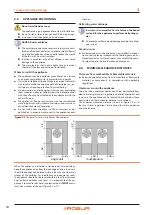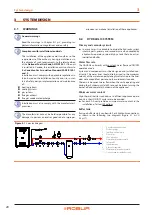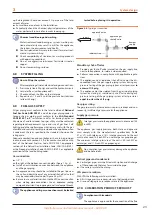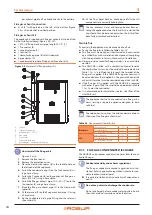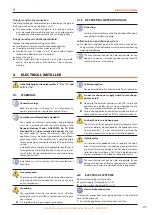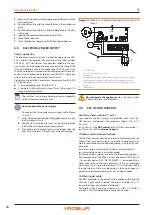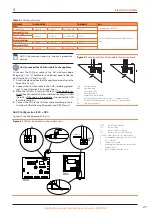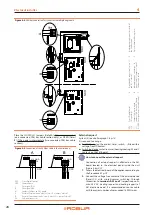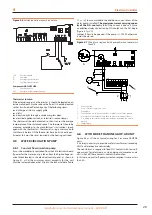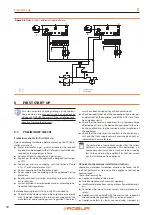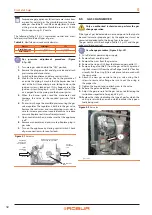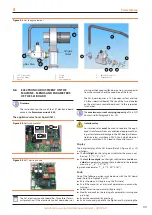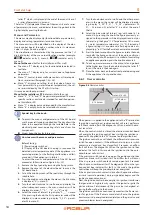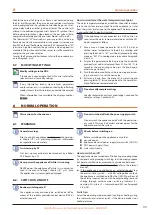
System design
22
3
Electrical and gas continuity
The active antifreeze self-protection is only effective if
the power and gas supplies are assured. Otherwise, anti-
freeze liquid might be required.
3.6
ANTIFREEZE LIQUID
To ensure the correct operation of the unit and to avoid
water freezing, add antifreeze glycol to the system water
as needed for the minimum external temperature of the
installation zone (Table 3.1
A minimum concentration of 10% by volume of ethylene
glycol (or 15% propylene glycol) is required in all heating
and cooling applications, including warm regions and
even if the water circuit is to be drained during winter
months. This is necessary to protect the unit's heat ex-
changer from freezing during light load operating con-
ditions or off periods. Otherwise, damage to the heat
exchanger will result.
Always use glycol that is permanently inhibited. Do not
use automotive antifreeze.
Precautions with glycol
The manufacturer disclaims any liability for any damage
caused by improper glycol use.
Always check product suitability and its expiry date with
the glycol supplier. Periodically check the product's pres-
ervation state.
Do not use zinc-coated piping and fittings (incompatible
with glycol).
Glycol modifies the physical properties of water (den-
sity, viscosity, specific heat...). Size the piping, circulation
pump and thermal generators accordingly.
With automatic system water filling, a yearly check of the
glycol content is required.
Type of antifreeze glycol
Inhibited type glycol
is recommended to prevent oxidation
phenomena.
Glycol effects
The Table 3.1
p. 22 shows, indicatively, the effects of using a
glycol depending on its %.
Table 3.1
Technical data for filling the hydraulic circuit
Propylene glycol correction factors
Percent propylene glycol
15%
20%
25%
30%
35%
40%
50%
Approximate freezing point in °F
24
18
15
9
5
-5
-30
Capacity factor multiplier (1)
0.992
0.986
0.972
0.960
0.950
0.928
0.878
Pressure drop multiplier (2)
1.04
1.08
1.13
1.21
1.26
1.47
2.79
Ethylene glycol correction factors
Percent ethylene glycol
10%
15%
20%
25%
30%
35%
40%
Approximate freezing point in °F
25
21
17
11
5
0
-10
Capacity factor multiplier (1)
0.98
0.96
0.95
0.93
0.92
0.91
0.89
Pressure drop multiplier (2)
1.08
1.11
1.16
1.21
1.27
1.32
1.38
1
At standard ARI 590 conditions: 54 °F entering fluid temperature, 44 °F leaving fluid temperature, 95 °F ambient temperature, 0.0005 fouling.
2
Pressure drops may vary with individual glycol manufacturer’s products. The information provided for pressure drop is typical but installing contractor / project engineer is responsible for
verification of pressure drop correction based on specifications of glycol used.
3.7
SYSTEM WATER QUALITY
Responsibility of the user/operator/installer
The installer, operator and user must assure system wa-
ter quality (Table 3.2
p. 22). Failure to comply with the
manufacturer's guidelines may affect operation, integ-
rity and life of the appliance, voiding the warranty.
For any further detail, please contact directly
Robur Corporation Evansville, IN, Phone (812) 424-1800;
Fax (812) 422-5117.
System water characteristics
Free chlorine or water hardness may damage the appliance.
Adhere to the chemical-physical parameters in Table 3.2
and the regulations on water treatment for residential and in-
dustrial heating systems.
Robur is not liable for ensuring that water quality is al-
ways compliant with what reported in Table 3.2
or is not.
Table 3.2
Chemical and physical parameters of water
Chemical and physical parameters of water in heating/cooling systems
Parameter
Measurement unit
Required value
pH
/
> 7 (1)
Chlorides
ppm
< 125 (2)
Total hardness (CaCO
3
)
°f
< 15
°d
< 8.4
Iron
ppm
< 0.5 (3)
Copper
ppm
< 0.1 (3)
Aluminium
ppm
< 1
Langelier’s index
/
0-0.4
Harmful substances
Free chlorine
ppm
< 0.2 (3)
Fluorides
ppm
< 1
Sulphides
ABSENT
1
With aluminium or light alloys radiators, pH must also be lower than 8 (in compliance
with applicable rules)
2
Value referred to the maximum water temperature of 176 °F
3
In compliance with applicable rules
Water topping up
The chemical-physical properties of the system's water may al-
ter over time, resulting in poor operation or excessive topping
Summary of Contents for GAHP-AR
Page 43: ......











